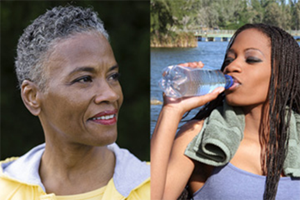Study: For some African-American women, hair care a potential barrier to exercise
According to the Centers for Disease Control, approximately four out of five black women are overweight or obese and 36 percent meet physical activity objectives as determined by the CDC. That’s compared to 50 percent of white women meeting the same objectives.
A study conducted by the Center for African American Health and the University of Colorado School of Medicine’s Center for Women’s Health Research finds that African American women whose hairstyle is affected by perspiration may avoid physical activity altogether. Prior studies have found that between 29 percent and 48 percent of African American women say that their hairstyle was a factor in deciding whether or not to exercise. One key focus of this study was to learn more about cultural barriers to physical activity among African American women — including hairstyle-related factors. Some women involved in the study who experience hairstyle barriers to physical activity explained that it can take too much time or money to restyle their hair after exercise that causes perspiration.
Although hairstyle maintenance barriers were reported less frequently than the most highly rated general barriers of “lacking self-discipline” and “lacking money”, they are important to understand in order to inform future interventions for the substantial number of sedentary AA women affected by hairstyle maintenance barriers.
What researchers found is that lower rates of exercise may be related to cultural barriers, including the costs and time required to restyle hair after exercise that causes perspiration. To reduce the time needed to restyle hair after exercise, some participants reported using “low-maintenance” hairstyles such as wearing braids or ponytails. In addition, some women described being cautious to do “safe” physical activities that do not cause perspiration, in order to overcome this barrier. This study found that 29 percent of African American women who did not exercise regularly experienced hairstyle barriers to exercise. In contrast, only 7 percent of African American women who exercised regularly reported their hair was a factor in deciding whether to exercise.
“After a couple of new health diagnoses, one of our study participants said she had to make a decision between her hair and her life,” said Lucille Johnson Campbell, MA, director of special initiatives for the Center for African-American Health and co-principal investigator for the study. “We want to find solutions so women in the African American community can get through these barriers and improve their health.”
Researchers assessed the health of participants and then used surveys and focus groups to identify hairstyle-related physical activity barriers and physical activity motivators. The study included 51 women from the Denver metro area ranging in age from 18 to 75 years. “The lifespan perspective from women of varying ages allowed for a greater range of discussion into understanding if hair influenced physical activity throughout generations,” said study investigator, Candace Brown, MAG, MEd, Doctoral Candidate at Virginia Commonwealth University.
The women were divided into two categories - “exercises” and “non-exercisers.” The ”exercisers” reported at least 60 minutes of weekly activity and the “non-exercisers” reported less than 60 minutes. Both groups reported similar rates of diabetes, pre-diabetes, and arthritis.
“There is some exciting news from this study,” said Amy Huebschmann, MD, associate professor at CU School of Medicine and the Center for Women’s Health Research and co-principal Investigator for this study. “African American women want to overcome these barriers to exercise, and we studied many African American women who have already overcome these barriers by adjusting their hairstyles. The next step is to develop and test programs to overcome general barriers and hairstyle-related barriers.” Study participants suggested various activities to get them moving, including dance classes and other fun group activities. They also suggested other helpful strategies to overcome hairstyle-related barriers to physical activity: social support from other African American women and culturally relevant education about moisturizing hair products to combat the dry Colorado climate and “low-maintenance” hairstyles that are minimally affected by perspiration.
Huebschmann added that a recent societal culture shift may also help African American women to overcome hairstyle barriers to activity. “We had some women describe concerns of getting fired if they came to work with a low-maintenance hairstyle such as braids or natural hair, but we also heard women saying that they feel there is a growing cultural acceptance of these types of low-maintenance hairstyles.”
These study results have been presented at the national scientific meetings of the Society of Behavioral Medicine and the Society of General Internal Medicine and at a community presentation organized by the Center for African American Health. The study investigators have submitted their findings for scientific publication by a medical journal.


